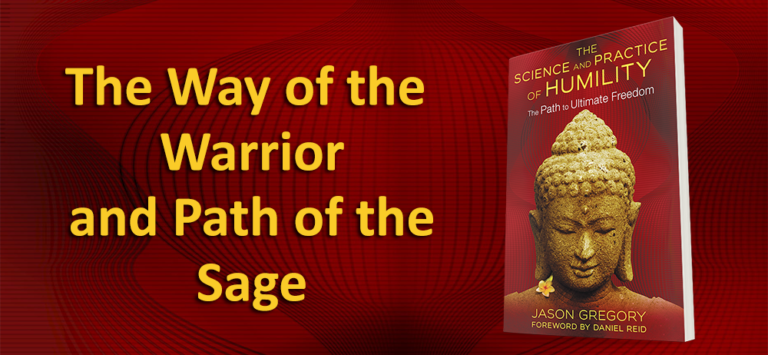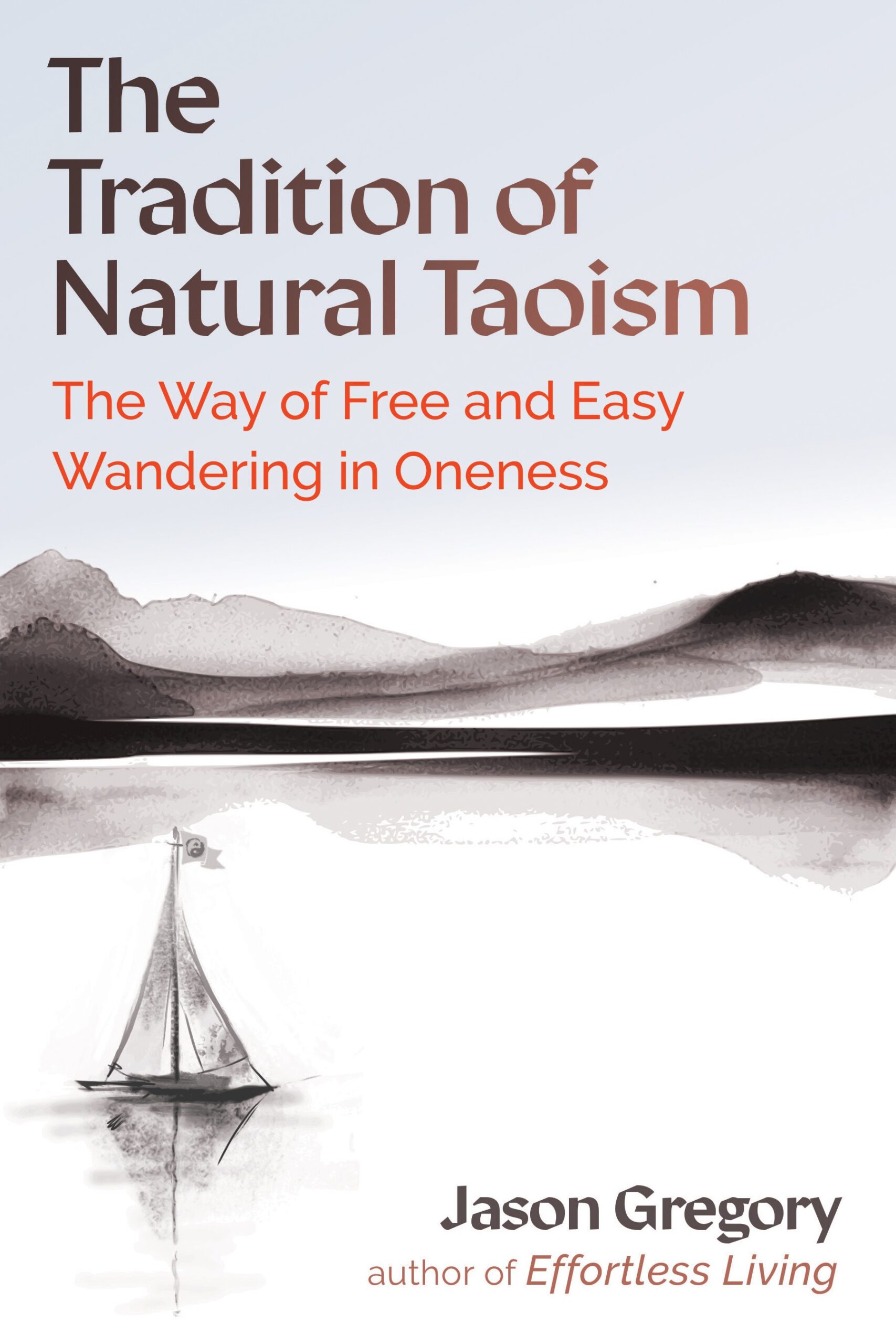The Way of the Warrior and Path of the Sage | Book Excerpt from The Science and Practice of Humility

A human has two primary states of awareness or modes of being. As we have mentioned there are those who are drawn into the daily dramas of life and those who have an elevated perspective, capable of seeing a fractal harmony within all life. These two states of awareness run parallel with the conscious state of the false ego and the true self, respectively. The ego perceives the fine details of reality. Like a microscope the ego focuses on the very tiny matters of life, then mistakenly builds its psychology around these insignificant situations. On the other hand the true self is the state of consciousness so pure that it constantly sees that life is pattern; in this state the unfolding universe can be visualized. This state of awareness is a mind of no deliberation, a mind that does not attach itself to any circumstance or thought—past, present, or future. The true self dwells within the spiritual plane and knows the soul vibrations, hence the evolution of perception. We associate this state of consciousness with a teacher of eternity or a sage, and the state of consciousness of the ego caught in the details with the masses or the profane. Both primary states of awareness are built into the universal structure. These two viewpoints have been an area of confusion throughout the ages. Yet both are necessary and together form a cosmic law.
The teacher and student relationship is found in all levels of life, whether as parent and child, teacher and student, or— the most mysterious of all—master and disciple. In the immutable relationship between master and disciple, the disciple is still deluded by the mind, whereas the master knows the totality of our being. These two modes are represented in ancient scriptures and mystical stories as “the warrior” and “the sage.” Many examples of a sage teaching a warrior are found in the Vedantic treatises of India, most notably the Bhagavad Gita and Ribhu Gita (Song of Ribhu). The Bhagavad Gita tells the story of Arjuna the warrior and Krishna the sage, while the Ribhu Gita refers to Nidagha the warrior and Ribhu the sage. In both classics the warrior is suffering from his own mind and plight within this world. As he begins to question his mind, the guidance of the sage appears. In both scriptures the whole process is to lift the warrior’s mode of perception out of the details of life into the vision of the Divine. In the Bhagavad Gita Krishna attempts to move Arjuna’s awareness out of the daily mundane struggles of life into the vision of Brahman, which is to see the infinite in all things. Verses 31, 32, and 33 of chapter 13 of the Bhagavad Gita state:
When a sensible man ceases to see different
identities due to different material bodies and
he sees how beings are expanded everywhere,
he attains to the Brahman conception.
Those with the vision of eternity can see
that the imperishable soul is transcendental,
eternal, and beyond the modes of nature.
Despite contact with the material body,
O Arjuna, the soul neither does anything nor
is entangled.
The sky, due to its subtle nature, does not mix
with anything, although it is all-pervading.
Similarly, the soul situated in Brahman vision
does not mix with the body, though situated in
that body.1
This is only one of many ways to interpret these scriptures, but this way of understanding the relationship between the warrior and sage is imperative to the practice of the science of humility. These two modes of being correspond to the flow of chaos (warrior) and order (sage) within consciousness. One of the biggest problems to plague this planet throughout time has been the fostering of the warrior’s consciousness and the continual suppression of the sage’s consciousness. It comes back to the individual, so there is no one to blame for this other than ourselves. Our obstinate refusal to look within ourselves to find the true problems in our world has allowed us to further justify our own habitual ways that are slowly killing the human species. For us to ward off this fate, we need to understand where our awareness is rooted. To do this we need to explore the characteristics of a warrior and a sage.
THE WARRIOR
The warrior is an ephemeral state of awareness that gets swept up in trying to change the world. To achieve this implied change, warriors attempt to impose their will on others. In the belief they are striving for world peace, they cause more trauma. The warrior does not know that fighting for a solution only increases a problem. Why do we fight? Here “fight,” means to have conflict or oppose some situation either within or without.
One of the major dilemmas of the human psyche is having the notion that something is either good or bad. When an individual judges if something is good or bad, it comes back to the false psychological state known as the ego: humans judge if something is good or bad according to their own conditioning from birth. Not being conscious of this, warriors seek to change the world according to their likes and dislikes. So a warrior does not truly want to bring peace to the world because he is in fact conspiring against it. The majority of beings on Earth have a warrior’s consciousness, which is evident in the chaos of the physical and mental worlds. Those who believe that what is right for them is the way for everybody else are not truly concerned about another being’s authentic way of life.
A warrior harbors an artificial internal conspiracy, that of believing that we are our thoughts and our accumulated conditioning. Buying into the grand delusion of conditioning fragments reality into chaos and separation. The warrior knows the chattering within the mind but is ignorant of the one who hears the thoughts. As warriors are only conscious of the physical and mental planes, they ignorantly perpetuate their beliefs of separation. These beliefs usually fall into the categories of political, religious, social, and so on.
If you are taking upon yourself the responsibility to change the world, on whose authority are you doing this? Is this through your dharma, which inspires others, or a belief system that you want to uphold? Warriors who try to push their personal agenda upon others through any means necessary get caught up in hatred and violence toward those who oppose that agenda. The question we need to ask is whether the world needs to change and according to whose plans?
As the warrior is projecting all of her inner falsified qualities on to the world, surely the salvation that needs to take place is within the individual. Those who are stuck in the awareness of a warrior, and are drawn into worldly affairs with an illusion of changing the status quo to their liking, will only contribute to decay on all levels of life, leading to the annihilation of the race. Real evolution has nothing to do with changing finite matters; it is only found by stepping out of worldly affairs with a determination to change the individual who sees the world.
THE SAGE
The great work of eternity is about refining the consciousness to a single point. This refined consciousness allows the individual to bring the eternal virtue of the science of humility into the manifest world. The single-pointed consciousness we are speaking of is not snagged by any thought, emotion, or external circumstance, because the awareness is rooted in the universal perspective. The one who knows the science of humility knows that to try to control any aspect of the universe is futile.
A sage is someone who is sincere in the search for the eternal within. Those with the evolved consciousness of a sage do not put off enlightenment for their next life as they know truth is only here and now. Nothing distracts their focus on how to truly see themselves and the totality of the cosmos. This is a major difference between a warrior and a sage: a warrior remains distracted by external events while a sage sees distractions as mental projections of the ego, and turns inward to see the true source of the problem. By turning within the sage realizes that the result of perceiving the world through the eyes of individual conditioning is that all judgments and desires are not based in the foundation of one’s being. A sage then seeks to eradicate latent tendencies and habitual ways of thinking from his consciousness. For warriors this is a scary undertaking, because the majority of beings on this planet will do anything to distract themselves from facing their own psyche. Sages do not see this as scary but as imperative to evolution and salvation. As they begin to move away from all of the external noise, more space begins to enter their being, which gives them the crystal clear clarity of how to see through the universal eye.
DEFINING THE DIFFERENCE
The subjective consciousness of the warrior is caught in the details while the objective consciousness of the sage sees correctly. In all esoteric work the whole purpose of any system is to take us from a subjective worldview to an objective reality. The more we refine our consciousness, the more we begin to access this objective reality.
Upon self-reflection the sage sees that what he wanted for the world and himself was attuned to his egocentric conditioning. So the process of ridding himself of his own inner conspiracy doesn’t end until the very last remnant of illusion is combed out. This process is what moves the sage from being concerned with worldly affairs. A sage knows fundamentally that to truly change the world, we need to change where the world comes from. And where it comes from is the individual’s perception of it. This is a bitter pill to swallow for some, because this means that force actually never truly changes anything. At best it may provide a momentary Band-Aid for a situation.
Force and humility are the two virtues that distinguish a warrior from a sage. Warriors see external events and seek to change them to suit their conditioning, yet this is a process of forcing their own version of reality upon others. In most cases this appears as a revolution. It doesn’t matter whether it is the overthrowing of a particular political party, religious group, or social system; they are all only temporary solutions from the same ground of the ego. Warriors do not see that they have their own agenda to perpetuate. What is most astonishing is that the inner and outer actions of the warrior actually imply that the universal design of creation is faulty and that God made a mistake. A warrior would not question the structure of his own abode, so how could he ignorantly question the structural design of consciousness? The illusion of separation continues to distort the universe through this ignorant mode of awareness until the vanity of the warrior is exposed through a fight that cannot and will not be won.
The sage, on the other hand, knows that no matter how hard we try, we will never defeat the universe and its unfoldment. The sage knows that life is pattern and each fragment of the universe is connected to every other part; nothing can escape this cosmic web. The sage sees no reason to fight because she is attuned to the universal harmony from her elevation of consciousness. Sages know it is absurd to question the design of the universe, so instead seek to find how they are part of the universe. Through their inner exploration, sages discover that the universe is in constant change and that this universal process is unfolding within them as well. So the grand choice becomes apparently clear: we can either fight the universal stream, or we can swim with it. We can force ourselves upon the universe, or become humble students of it.
The gulf of understanding between a warrior and a sage has been with humanity since ancient times. The teacher of eternity known as Chuang-tzu once described an imaginary dialogue between two of the great masters of antiquity, Confucius and Lao-tzu. It is believed that Confucius was a disciple of Lao-tzu. In this dialogue you will see a conversation between a warrior and a sage beautifully depicted.
“Tell me,” said Lao-tzu, “in what consist charity and duty to
one’s neighbour?”
“They consist,” answered Confucius, “in a capacity for rejoicing in all things; in universal love, without the element of self. These are the characteristics of charity and duty to one’s neighbour.”
“What stuff!” cried Lao-tzu. “Does not universal love contradict itself? Is not your elimination of self a positive manifestation of self? Sir, if you would cause the empire not to lose its source of nourishment—there is the universe, its regularity is unceasing; there are the sun and moon, their brightness is unceasing; there are the stars, their groupings never change; there are the birds and beasts, they flock together without varying; there are the trees and shrubs, they grow upward without exception. Be like these: follow Tao, and you will be perfect. Why then these vain struggles after charity and duty to one’s neighbour, as though beating a drum in search of a fugitive. Alas! Sir, you have brought much confusion into the mind of man.”2
The unfoldment of the universe is always teaching us that no matter how hard we try, things are just as they are supposed to be. On another level they are paradoxically viewed as problems to be overcome. These two ways of perception are built into the fabric of the universe, with both a warrior and a sage playing their role in the grand unfoldment of the cosmos. While warriors see separate parts and seek to change them, the sage sees the totality of the universe. The sage does not fight anything either within or without, because distinctions do not exist for a sage. The sage begins to act and move as the universe does, and the evolution of perception brings the realization that the focus of attention that the warrior possesses is only a part of the universal makeup.
The sage’s revelation is the understanding that even if warriors aspire to go beyond the mind and reach enlightenment, they will always fall short. Even though the goal is higher, trying to reach it by fighting will not be successful. Ultimately the sage reveals the wisdom of the universe: that no matter how hard you try, you cannot hold on to yourself. This is what is referred to by terms such as samadhi, satori, and enlightenment. As a reflection of the universe a sage will change with it. The process of the universe is not something that takes gigantic leaps; it moves in very small stages. So the movement of perception from that of a warrior to that of a sage is a constant flow of conscious energy. Like a mountain stream the universal stream moves in a fluid motion without being attached to what is perceived as external reality; in not being caught anywhere, it moves toward the larger body of water.
The Science and Practice of Humility by Jason Gregory © 2014 Inner Traditions. Printed with permission from the publisher Inner Traditions International. www.InnerTraditions.com
Notes
1. Prabhupada, Bhagavad Gita As It Is, 561–63.
2. Watts, The Way of Zen, 26.
Buy The Science and Practice of Humility
Amazon Paperback http://amzn.to/2z01WPb
Amazon Kindle https://amzn.to/2us859i

